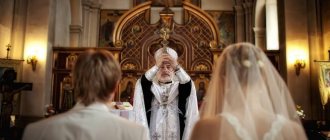For Catholics, marriage is more than just a civil contract between a woman and a man. This is, first of all, a spiritual union. In other words, it is a sacramental commitment between you, Christ and the church.
Typically, the priest of the archdiocese sets his own rules and requirements for marriage in the Catholic Church between representatives of a given religion. It should be noted that preparation for the solemn event will take at least six months.
Some temples additionally require pre-wedding courses. This article examines in detail the question of how to properly conclude a marriage between a Catholic and a Catholic.
Peculiarities
From the point of view of the Catholic Church, a sacrament is characterized by:
- holiness is the connection of two people with God;
- unity - the union of spouses into one whole;
- indissolubility - the eternity of the marriage union even in the afterlife; Divorce is possible in very rare cases.
Interesting! In Christianity, the family, that is, the church union of a man and a woman, is called the “small” or “domestic church.”
Terms and Conditions
In order to adequately prepare for the wedding ceremony, future spouses must meet several conditions:
- contact the clergyman of the parish where they intend to conduct the marriage ceremony 3 months before the wedding;
- be in an officially registered marriage;
- undergo special pre-marital preparation.
You need to know the basic prayers and rituals of the Catholic Church:
- "Our Father";
- "Symbol of faith";
- "To the Virgin Mary";
- gospel commandments;
- 6 truths of faith;
- 5 church commandments;
- "Angel of the Lord";
- Holy Rosary;
- order of baptism;
- church sacraments;
- preparing the home for the sacrament of the sick;
- 5 conditions for the sacrament of reconciliation.
The best churches in Spain to celebrate a Catholic wedding:
We have them and they are in Spain. In our country there is no shortage of beautiful cathedrals and churches where you can have a Catholic wedding.
That's why we're going on a little trip to the most beautiful cathedrals in Spain of all time.
Nueva Son Servera New Church of Son Servera, Mallorca
Photo via Danyel André Wedding Photographer
Unfinished church ? This building has undergone changes and remains completely unfinished. And it was designed by one of Gaudi's students. It features architectural elements typical of the Gothic Revival, a noticeable austerity, windows and rose windows, as well as a special magic associated with the fact that it is open to the sky. Beauty, accessed through a small garden !
Cathedral of Santiago de Compostela, Galicia
Photo via Hervé Hughes/Gtres
Because numerous pilgrims crossed mountains and valleys to reach this cathedral in the Middle Ages, it is now the most visited cathedral in Spain . This temple, built over the tomb of Santiago, is in the Romanesque style and has a Latin cross plan and three naves with Gothic, Baroque, Plateresque and Neoclassical elements.
This city smells like the Middle Ages!
Mosque of Cordoba, Andalusia
Photo via RayPorres Fotografía
One of the most unique cathedrals in Spain, this is a gem of Umayyad art. Along with the Alhambra in Granada, it is the greatest example of Islamic architecture in Spain . Its swarm of red and white doves forming arches supporting its roofs will leave you speechless.
Cathedral of Burgos, Castile and Leon
Photo via Xacopedia
This is the only Spanish cathedral listed as a UNESCO World Heritage Site. It was built between 1221 and 1765, so other styles join the dominant Gothic style. The Spanish national hero Rodrigo Diaz de Bivar and his wife Jimena are buried under its arches. In front of the cathedral there are two beautiful medieval fountains.
For the most historic wedding.
Basilica of Our Lady of Pilar, Zaragoza
Photo via Fotonazos
The most visited of Zaragoza's two cathedrals . This is a Baroque temple with three naves and four towers. Did you know that on the site where the temple now stands there was already a Mozarab church dedicated to Santa Maria? That is why its origin dates back to the 9th century.
Cathedral of Primada Toledo
Photo via Fisfra
The main cathedral of Spain , this French-influenced Gothic-style temple has a floor plan consisting of five naves supported by 88 columns and 72 vaults. It has polychrome stained glass from the 14th, 15th and 16th centuries, and its choir is considered the greatest in Christendom.
Cathedral of the Good Shepherd, San Sebastian
Photo via San Sebastián Turismo-Donostia Turismoa, SA
This is the largest religious building in San Sebastian, which towers over the city center and has a needle shape 75 meters high , so it can be seen from almost all points of the capital. It is believed that it is very similar to the Cologne Cathedral, in the likeness of which, as is commonly believed, it was built in the 19th century. It was built from stone masonry from the quarries of Mount Igueldo.
Basilica of the Cathedral of San Salvador, Oviedo
Photo via Viajes Camino de Santiago
You don't know how many relics it contains! Similar to the famous Holy Shroud, a piece of linen cloth that was the cloth covering the face of Jesus Christ during his burial in the tomb .
Getting married here is an honor.
Preparation
At the first meeting with the priest, the newlyweds (they are also called the betrothed) agree on the procedure for taking special pre-marital courses to get acquainted with the Catholic foundations of marriage, family, and the role of spouses in raising children.
Thus, the Catholic Church is categorically against the use of any contraception and considers it a great sin. Only the physiological method of planning the birth of a child is acceptable.
The need for active participation in the life of the church, observance of Christian commandments, and introducing children to the faith is discussed. Usually there are 10 such conversations.
Interesting! In the Catholic tradition, there is a custom of engagement, that is, young people notifying their family and friends of their intention to marry.
The bride and groom must prepare and undergo the sacraments of confession and Eucharist (communion), which are preceded by fasting.
Catholic wedding
After completing all the preparatory activities, the most joyful and solemn moment is approaching - the Catholic wedding. Let's find out all the nuances of this unique sacrament and look at the photos taken during this ceremony.
The right time for a wedding
Firstly, church marriage is permitted only after official registration in the registry office. But the church itself does not set time limits. That is, if you really want, you can get married even during Lent, but basically everyone tries to avoid this period. If the sacrament will take place during Lent, there is only one condition - the refusal of the holiday in honor of the Catholic wedding.
Betrothal of young people of different faiths
The most common situation is when both spouses belong to the Catholic Church. In this case, there are no canonical obstacles to marriage. But it happens that one of them is a representative of another religion. In this case, there are a number of peculiarities during a wedding.
Catholic and Orthodox or Protestant
If one of the betrothed belongs to another Christian denomination (Orthodoxy, Protestantism), then permission for such a marriage is given by the bishop of the corresponding diocese.
Important! Catholicism also recognizes as legal marriages performed in the Orthodox Church.
The newlyweds make a promise to raise their future children in the Catholic faith. Information about the married couple and the signatures of the spouses under such a promise are entered in a special form.
Wedding with an unbaptized person
If one of the spouses is unbaptized (atheist, Jew, Muslim, Buddhist), that is, does not belong to Christianity, then obtaining permission from the bishop becomes much more difficult. There is no canonical ban on such marriage, but each case is considered individually. The clergyman talks with the newlyweds about the difference in cultures and the possible difficulties of such a union.
The final decision rests with the bishop.
On formalizing relations with non-Orthodox people
First you need to understand what the concept of “heterodox” is. This is the name of non-Orthodox Christian confessions, which include Catholicism, Protestantism, and Armenian-Gregorianism.
It must be remembered that the clash of approaches that were adopted in the Catholic and Orthodox churches and, in some cases, so different in solving intra-family problems when marrying between representatives of different religious denominations can lead to difficult situations in the family.
If you pay attention to the church practice of recent centuries, the Orthodox Church allows marriages between Catholics and Orthodox Christians . Moreover, the church allows union only with those Christians whose baptism it recognizes.
The latter, upon entering the fence of the Orthodox Church, are received in the second or third order - in other words, through Repentance and Confirmation. This includes Catholics, Protestants, Old Believers, and Ancient Eastern Christians. Only if all conditions are met can the Sacrament of Marriage be performed and such a marriage will be recognized as valid.
The right time
The sacrament of wedding according to the Catholic rite is performed almost all year round. The spouses themselves usually prefer to get married outside of fasting days, but there is no direct prohibition on this.
When getting married during Lent, you should not have a loud celebration after the ceremony with many competitions and a noisy feast.
Prohibitions on weddings in churches
The performance of the sacrament of wedding is prohibited in the following cases:
- those intending to enter into a church marriage are relatives (father and daughter, brother and sister) or half-brother and sister;
- one of the possible spouses is already in a church marriage;
- the physical impossibility of one of the spouses to perform marital duties, but infertility is not an obstacle to participation in the wedding;
- the murder of a husband or wife by one of the spouses for the sake of entering into a new marriage;
- the intended ones are cousins (theoretically, such a union is possible with the permission of the bishop, but in practice it is issued in exceptional cases);
- one of those wishing to marry is a clergyman or monk (nun).
Even if the wedding sacrament was performed, and the circumstances listed above later became clear, the ceremony is considered invalid.
From the point of view of the Catholic Church, marriage is indissoluble. A marital union can only be terminated by the death of one of the spouses. In the Catholic Church, unlike the Orthodox Church, there is no possibility of debunking. After a divorce (without a previous wedding), you must provide a certificate of divorce.
How is the Catholic wedding ceremony performed?
A Catholic wedding begins with the groom waiting for the bride at the altar. Her father or closest relative can bring her to the groom. This moment is one of the most touching in a Catholic wedding. Make sure you have a photographer, the photos will turn out simply magical.
The conduct of the wedding ceremony itself depends on the priest. There is no such scenario. There are certain prayers that the priest must read during the wedding. And there are questions that he will ask the newlyweds:
- Have you come voluntarily and want to conclude this alliance?
- Will you respect and love each other until the end of your days?
- Do you promise to raise your children according to the rules and laws of the Catholic Church?
If any of the newlyweds answer “no” to at least one of the questions asked, the wedding will be stopped immediately. Well, if the answers are positive, then the priest ties the hands of the newlyweds with a ribbon. At this moment, the couple turns to face each other and pronounces the words of a special oath. Usually it does not need to be learned by heart, the priest will read it himself, and you only need to repeat it.
Then the couple exchanges wedding rings and the Lord's Prayer is recited. It is worth noting that rings are not mandatory in the church. If you don't want to exchange rings, just let us know in advance. Then the priest blesses the newlyweds, and this ends the sacrament. Typically, the entire Catholic wedding ceremony from start to finish takes no more than half an hour.
Ceremony in the church
There is no strictly regulated ritual order that is uniform for all dioceses. It may vary depending on the area and the priest who performs the wedding. However, a number of characteristic details still exist.
The ceremony is performed by a clergyman. In special cases, he can be replaced by a pious layman.
Start
Usually the wedding ceremony takes place in a church. As a rule, the bride is brought to the altar by her father or another man who has taken upon himself the responsibility of caring for her (uncle, older brother). They are followed by little girls who scatter flower petals from a basket. At this time, the groom with witnesses and other guests is waiting for his future wife in the temple.
Less often, newlyweds enter the church together, holding hands. The bride is not required to wear a wedding dress, and the groom is not required to wear a suit. All that is required is the observance of neatness corresponding to the solemnity of the sacrament. At the altar, the betrothed stand or sit on special chairs with cushions.
Catholic tradition requires the participation of witnesses (up to three people on each side). Witnesses may belong to any Christian denomination. Bridesmaids often wear matching dresses. A special role is given to a little girl from among the guests, who is dressed up in a wedding dress. It symbolizes the purity, purity and spirituality of the future marriage union.
Liturgy
The wedding ceremony is preceded by a liturgy, after which the priest reads small fragments from the Bible and delivers a sermon on the importance of church marriage, the role of each spouse in the family, and the need for careful upbringing of children.
Then the couple getting married has a conversation with the clergyman, during which he asks the future spouses questions about the presence of any obstacles to getting married:
- Did you come to the temple voluntarily, and is your desire to enter into a legal marriage sincere and free?
- Are you ready to remain faithful to each other in sickness and in health, in happiness and in misfortune, until the end of your life?
- Do you intend to lovingly and gratefully accept the children God sends you and raise them according to the teachings of the church?
These questions make it possible to verify the sincere and free desire of the young people, their Christian view of the sacrament of wedding and family ties.
Vows and engagement
If the couple answered affirmatively to all questions, the priest asks the Holy Spirit to descend on the spouses. They offer each other their hands, which the priest ties together with a ribbon. Then the newlyweds, standing face to face, read their marital vows and take a vow of fidelity. The groom does this first, followed by the bride. They often complement them with their own words of love and gratitude to family and friends.
Interesting! Previously, in the Catholic Church there was a custom to decorate the temple gates with metal ringing objects to attract good luck to the future family.
After the oath, the groom's main witness hands him the wedding rings, the groom puts the ring on the bride's ring finger, and she puts the ring on the groom's. The priest says the Lord's Prayer, the Intercessory Prayer and blesses the newlyweds. Newly-made spouses sign in the church register.
Wedding rings are not a mandatory attribute of a wedding in Catholicism. If they are available, the clergyman conducts the consecration ceremony. Rings are an addition to the ceremony itself, which symbolize the fidelity of the newlyweds and their receipt of grace.
In most Catholic countries: France, Slovenia, Croatia, Czech Republic, Italy, Slovakia, the ring is traditionally worn on the ring finger of the left hand. A wedding ring is worn on the right hand in Poland, Austria, Spain, and Argentina.
The entire sacrament of wedding takes about half an hour.
Joint marriages of Catholics
The Catholic wedding ceremony is distinguished by solemnity and holiness, since it is performed only once and forever. The bride and groom must swear fidelity to each other and promise to support their spouse in all life situations. The future husband and wife enter into a kind of agreement with the church that they will be together forever.
Generally, this conditional contract cannot be terminated under any circumstances. According to Catholic rites, it is the father who leads the bride to the altar. He places his daughter in the safe hands of the groom to take care of her.
It should be noted that there are several steps prior to marriage between a Catholic and a Catholic:
- First of all, a couple who is about to get married should contact their priest. It is necessary to schedule a conversation with a clergyman six months before the expected wedding date. This will allow you to have the time necessary to resolve various disputes and conflict situations;
- You should definitely meet with the priest to decide on the wedding date and time of the wedding. After completing all the initial paperwork for a Catholic wedding ceremony, it is recommended that you schedule to take a Faith and Readiness Test and register for a pre-marriage course or workshop;
- It is further recommended to ensure that the bride and groom are eligible for a Catholic wedding ceremony. The Church requires that at least one of those marrying is a member of the Catholic faith;
- It is imperative to provide a marriage certificate and all related documentation, including various premarital baptismal forms, confirmation of certificates and all kinds of orders or permissions. Additionally, if necessary, you should obtain copies of applications for cancellation of the document or a death certificate of the previous spouse;
- You should also ask your priest for a copy of the Rite of Marriage, as well as a guide for planning liturgical readings;
- Next, you need to test your own faith in order to be ready for a Catholic marriage before a clergyman. The latter will be based on personal assessments of the oral and written responses on the part of the bride and groom. Since marriage in the Catholic Church is a sacred sacrament, the priest must make sure that you are a believer. This is a mandatory condition preceding marriage. If a clergyman has doubts about the faith of a particular person, he may not allow him to marry;
- Next, the bride and groom should take an oral or written compatibility test if the priest asks them to do so. This helps the minister of the church and confirms the decision of a particular couple to enter into a marriage union;
future husband and wife may choose to attend one of the parish's approved premarital counseling programs, also known as prenuptial programs. These can be in the form of weekend getaways or two-hour seminars. The latter cover a time period of up to several weeks. An approved premarital counseling program covers topics such as the role of prayer and faith, as well as finances and family planning. Upon completion of the training course, the couple receives a corresponding certificate of marriage by a priest;- It is further recommended that you consult with your priest after meeting all requirements. He needs to communicate his own liturgical readings and choice of music for the upcoming ceremony. The clergyman will also inform you that the bride and groom must make a confession before taking their own vows.
In some cases, the details of the wedding process in the Catholic Church may differ significantly. The priest has the right to refuse any demands that are based on individual conditions. For example, couples who are widowed do not need additional premarital counseling.
It is also worth considering this point: if the bride and groom belong to different Catholic churches, then you should consult with a clergyman about subsequent actions. Additionally, you should contact the city hall or town hall to obtain the appropriate permission to marry.










